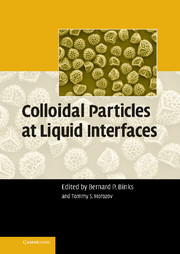Book contents
- Frontmatter
- Contents
- Preface
- List of Contributors
- 1 Colloidal Particles at Liquid Interfaces: An Introduction
- Section 1 Particles at Planar Liquid Interfaces
- Section 2 Particles at Curved Liquid Interfaces
- 5 Particle-Laden Interfaces: Rheology, Coalescence, Adhesion and Buckling
- 6 Solids-Stabilized Emulsions: A Review
- 7 Novel Materials Derived from Particles Assembled on Liquid Surfaces
- 8 Interfacial Particles in Food Emulsions and Foams
- 9 Collection and Attachment of Particles by Air Bubbles in Froth Flotation
- 10 Antifoam Effects of Solid Particles, Oil Drops and Oil—Solid Compounds in Aqueous Foams
- 11 Metal Foams: Towards High-Temperature Colloid Chemistry
- Index
10 - Antifoam Effects of Solid Particles, Oil Drops and Oil—Solid Compounds in Aqueous Foams
Published online by Cambridge University Press: 11 October 2009
- Frontmatter
- Contents
- Preface
- List of Contributors
- 1 Colloidal Particles at Liquid Interfaces: An Introduction
- Section 1 Particles at Planar Liquid Interfaces
- Section 2 Particles at Curved Liquid Interfaces
- 5 Particle-Laden Interfaces: Rheology, Coalescence, Adhesion and Buckling
- 6 Solids-Stabilized Emulsions: A Review
- 7 Novel Materials Derived from Particles Assembled on Liquid Surfaces
- 8 Interfacial Particles in Food Emulsions and Foams
- 9 Collection and Attachment of Particles by Air Bubbles in Froth Flotation
- 10 Antifoam Effects of Solid Particles, Oil Drops and Oil—Solid Compounds in Aqueous Foams
- 11 Metal Foams: Towards High-Temperature Colloid Chemistry
- Index
Summary
Introduction
The antifoam effect
Foams appear as an integral part of various technological applications, such as ore and mineral flotation, tertiary oil recovery, production of porous insulating materials, fire fighting and many others. Foams are also encountered in certain types of consumer products, e.g. the mousses and ice-creams as food products, and shaving and styling foams in cosmetics. It has been known for many years that the presence of oil droplets and/or hydrophobic solid particles in the aqueous foaming solutions can strongly reduce the foaminess and foam stability, which might be a problem in various applications. For example, the fat particles in food products and the droplets of silicone oil used in personal care products (such as shampoos and hair/skin conditioners) have a strong antifoam effect, which should be suppressed to achieve an acceptable product quality from a consumer viewpoint.
On the other hand, excessive foaming might create serious problems in many industrial processes. Typical examples are during fermentation in drug and food manufacturing, the processing of drug emulsions and suspensions, pulp and paper production, industrial water purification, beverage production and packaging, textile dyeing, oil rectification and many others. That is why special additives called “antifoams” or “defoamers” are widely used in these and other industrial applications to suppress foam formation or to destroy already formed foam.
Information
- Type
- Chapter
- Information
- Colloidal Particles at Liquid Interfaces , pp. 383 - 444Publisher: Cambridge University PressPrint publication year: 2006
Accessibility standard: Unknown
Why this information is here
This section outlines the accessibility features of this content - including support for screen readers, full keyboard navigation and high-contrast display options. This may not be relevant for you.Accessibility Information
- 18
- Cited by
